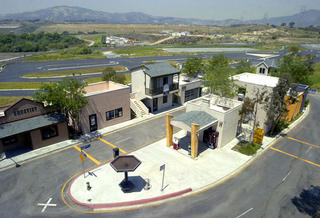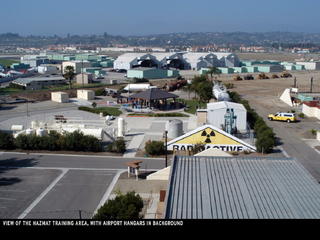In an interesting post on Design Observer, William Drenttel looks at disaster-preparedness exercises in Manhattan and West Virginia, in which fake catastrophes are role-played in otherwise everyday landscapes.

His post brings to mind an older exhibition at the Center for Land Use Interpretation (CLUI) in Los Angeles, which extended this analysis into a look at law enforcement training architecture—that is, totally abstract American “towns” where police, SWAT teams, FBI agents, fire crews, etc., can storm buildings, kick down doors, set up temporary command posts, and more.
That exhibition, called “Emergency State: First Responder and Law Enforcement Training Architecture” is totally fascinating, and well worth taking a look at. What’s particularly interesting is that these training villages, built to look as abstract and everyday as possible (complete with fake Starbucks, fake ATMs, fake drive-thrus), as if they are the absolute value of nowhere, actually just look like the United States.

That is, of course, their point. “Condensed simulacrum of our existing urban environments are forming within our communities,” CLUI writes, “where the first responders to emergencies, on a small or large scale, practice their craft of dealing with disaster.” Or, using a more Ballardian vocabulary, “Whether they are made for police or fire departments, these training sites are stylized versions of ordinary places, with the extraordinary horrors of the anticipated future applied to them on a routine basis.”

This opens up the somewhat more intellectually vertiginous implication that the United States already is a training landscape, militarized in advance and gridded for a surveillant centralization of control.

Susan Willis here comes to mind as someone writing about the strange, even uncanny, topology formed by America’s everyday national landscape and its overlapping, militarized simulation. “Operation Robin Sage,” in the pinelands of North Carolina, for instance, was a military training exercise that involves unwitting civilians and “real” streets and buildings for its successful execution:
Staged over a period of weeks, [Operation Robin Sage’s] scenes and acts occurring randomly across a 4,500 square-mile swathe of countryside, the play is sporadic and unpredictable. Weapons lend excitement. According to the Army’s script, no real soldier may carry live ammunition. But because North Carolina is a gun-toting state, citizens would be foolish not to duck and cover at the sound of gunfire. Thus, when Jessica Keeling ‘heard a spray of mock machine-gun fire behind the Citgo filling station . . . she quickly locked the doors, herded customers playing video poker into the store’s walk-in refrigerator and dialed 911.’ Keeling was an unscripted local, who without knowing it, fulfilled a role in what turned out to be a hostage-rescue scene staged by the Army at the body shop next door. Other unscripted locals have been chased and rounded up by military operatives who had mistaken them for locals scripted as guerrilla fighters. And one unscripted elderly couple was recently held at gunpoint in their home by soldiers decked out with face paint, camouflage and M-4 carbines.
Those interested in reading more can find Susan Willis’s complete article in the New Left Review.